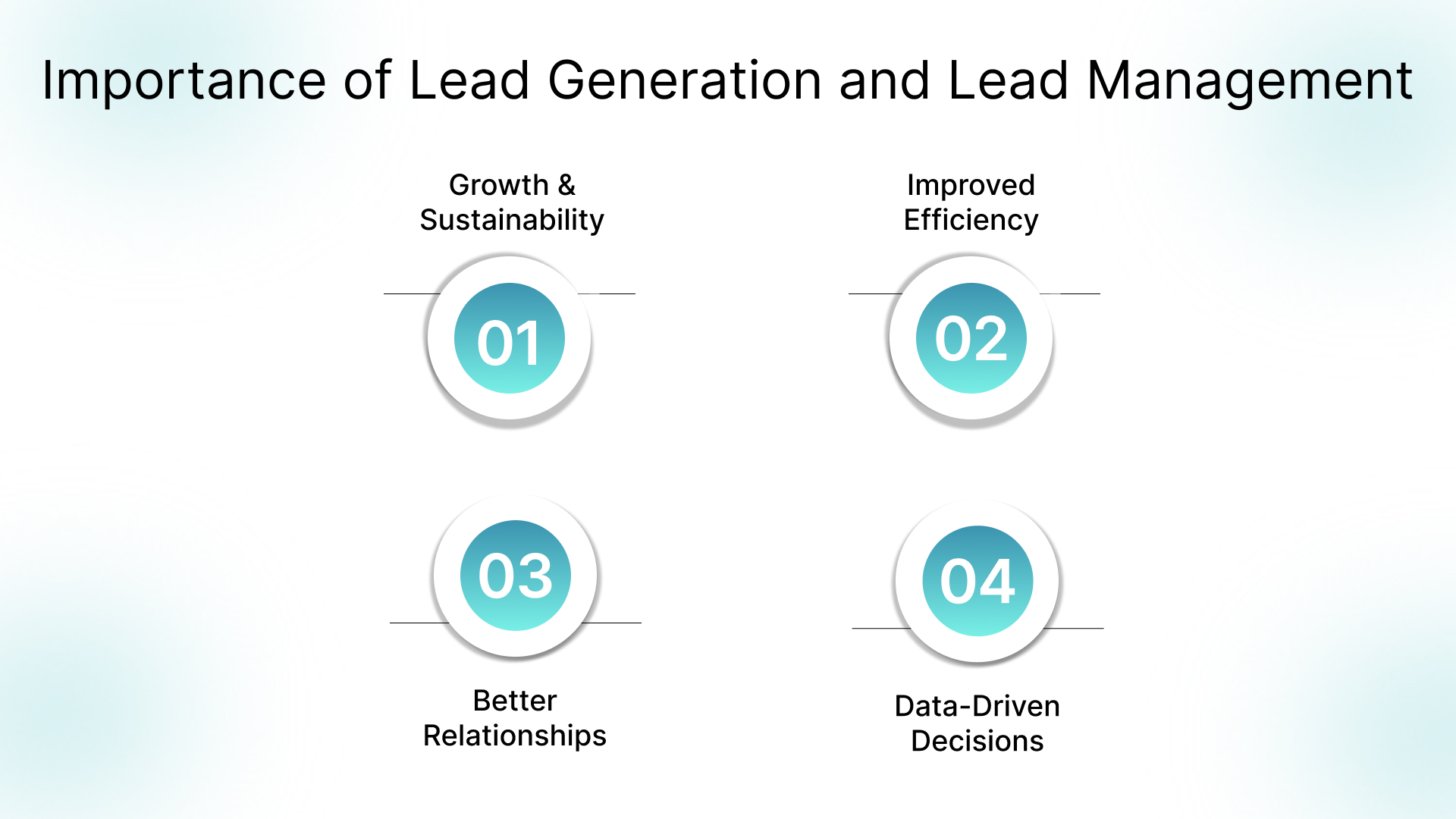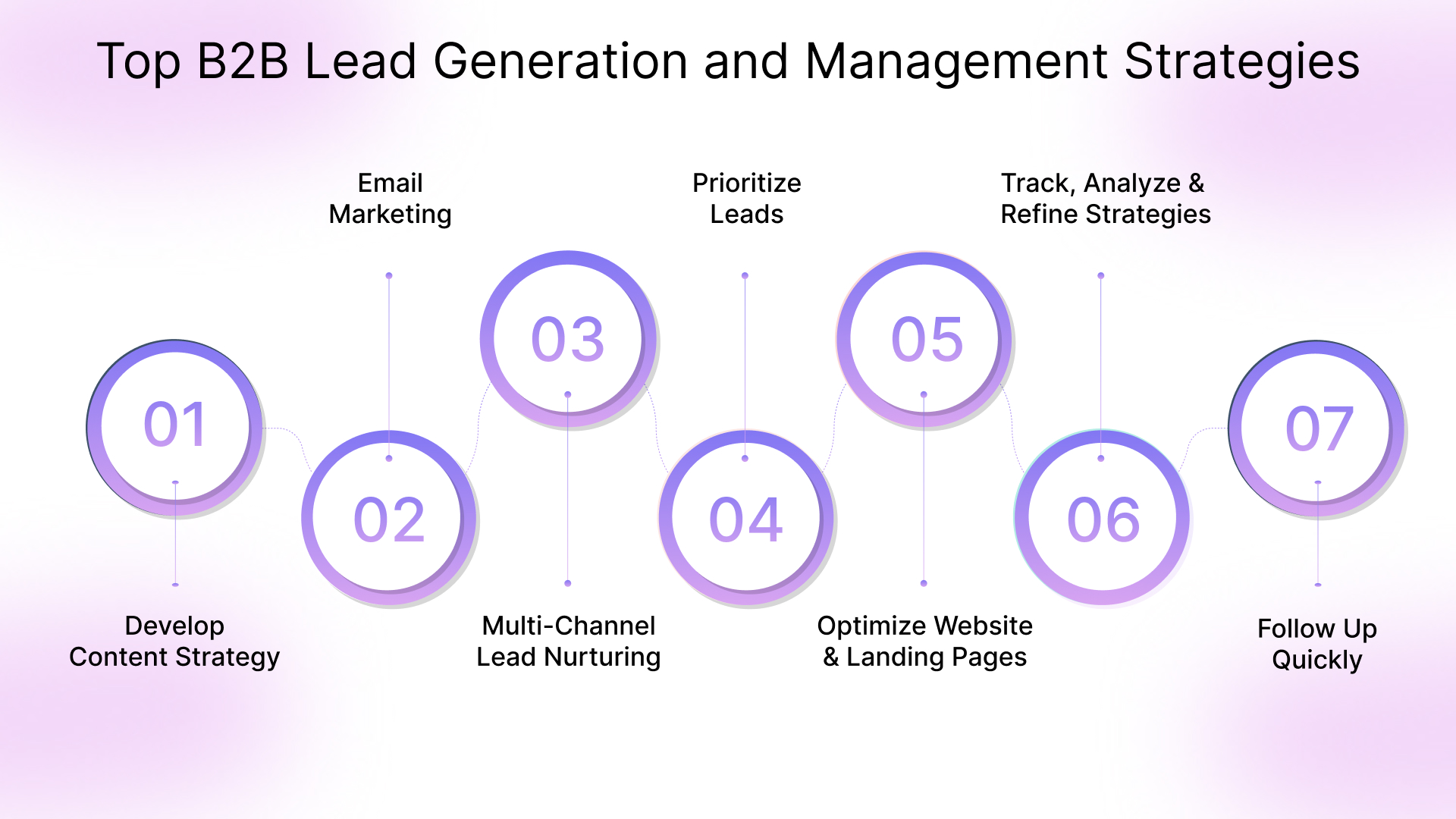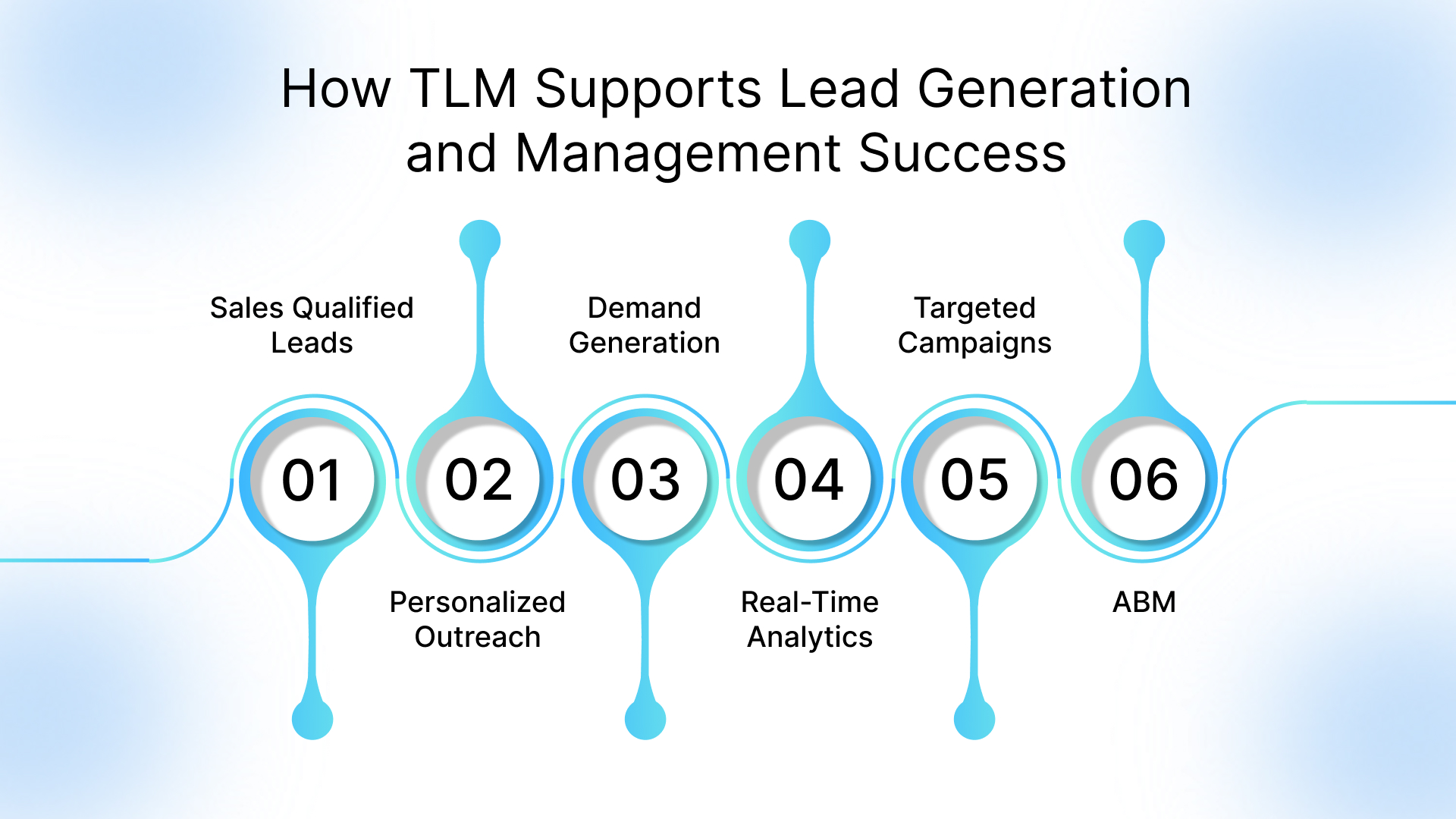
How to Master Lead Generation and Management Techniques

Lead generation and management are ongoing challenges for sales and marketing teams. According to a 2024 report, marketers view lead acquisition as mission-critical, yet many still struggle to convert these leads into tangible sales effectively. This disconnect often leads to missed opportunities and wasted resources.
It’s completely understandable to feel overwhelmed when trying to manage a constant flow of leads, each requiring attention and follow-up. The pressure to keep everything organized and moving through the pipeline can be exhausting, but rest assured, you're not alone in this struggle.
With the right strategies in place, you can simplify the process, regain control, and start seeing better results. In this blog, we’ll walk through actionable techniques to help you master lead generation and management, making the process smoother, more efficient, and ultimately more rewarding for your business.
TL;DR
- Lead generation brings in qualified B2B prospects; lead management nurtures and converts them
- Focus on strategies like email marketing, lead scoring, multi-channel nurturing, and quick follow-ups
- Common blockers: poor targeting, weak nurturing, slow response, and sales-marketing gaps
- The Lead Market (TLM) helps streamline lead workflows for better conversion
- Master both to build a stronger pipeline and drive consistent growth
Understanding B2B Lead Generation and Lead Management
In the world of B2B (Business-to-Business) sales, effectively generating and managing leads is essential to building a robust sales pipeline and ensuring consistent revenue growth.
While both lead generation and lead management are integral to mastering the sales process, each plays a unique role in driving business success. Here’s a breakdown of these crucial concepts and how understanding them can help you optimize your approach.
What is B2B Lead Generation?
B2B Lead generation is the process of attracting and capturing potential customers (leads) for your business. The B2B context focuses on identifying other companies that might be interested in your products or services and gathering information about key decision-makers within those organizations.
It typically involves a combination of tactics designed to attract businesses and engage with their decision-makers. These tactics can range from digital marketing techniques, such as e-mail marketing, to traditional methods like networking at industry events.
What is B2B Lead Management?
Once you’ve captured leads, the next step is lead management. This process involves understanding where each lead is in their buying journey, tailoring your messaging to match their needs, and prioritizing high-potential leads to move them toward conversion.
Effective lead management ensures that your team is not wasting time on leads that are not a good fit and that your most valuable prospects are given the attention they need to close deals.
Also Read: What are Leads in Business and Their Importance?
Why Are Lead Generation and Lead Management Important?

Both lead generation and lead management are vital components of a successful sales strategy. Without one, the other cannot function optimally. Generating leads brings prospects into your sales funnel, while effective lead management ensures these prospects are properly nurtured and guided toward conversion.
Below are several key reasons why both are crucial for business success:
- Growth and Sustainability: Generating a steady stream of leads ensures that your sales pipeline remains full, allowing for consistent revenue growth. Effective lead management helps you convert those leads into loyal customers, ensuring long-term business sustainability.
- Improved Efficiency: With lead management techniques like scoring and segmentation, your sales team can focus their efforts on the leads with higher chances of conversion, so no time is wasted on low-interest prospects. This leads to greater productivity and higher conversion rates.
- Better Relationships: Lead generation attracts potential customers, but lead management builds and nurtures those relationships. By understanding where your leads are in their journey and tailoring your communication accordingly, you’re more likely to build trust and eventually close the sale.
- Data-Driven Decisions: Both lead generation and lead management provide valuable insights into your prospects’ behavior. By analyzing these insights, you can continuously fine-tune your strategy to drive stronger marketing and sales outcomes.
Getting lead generation and management right is crucial for fueling consistent growth and keeping your sales pipeline healthy. By nurturing prospects effectively, you'll increase conversions and build lasting relationships. Let’s explore the strategies that can help you do just that.
Top B2B Lead Generation and Management Strategies

Generating and managing leads can feel overwhelming, but breaking the process down into clear, actionable steps can make it much easier. Whether you're working on attracting new prospects or nurturing existing ones, each step is crucial for building a successful sales pipeline.
Here’s how to effectively implement Lead Generation and Lead Management strategies:
1. Develop a Content Marketing Strategy
Content marketing helps you gain authority and trust in your industry and attract leads by offering valuable information. The right content can draw prospects in and start the conversation.
What you should do:
- Identify your audience's pain points: Understand what problems your target audience is trying to solve and create content around these issues.
- Create various types of content: Use blogs, case studies, whitepapers, videos, and infographics to cater to different types of learners.
- Distribute consistently: Post regularly on your website, blog, and social media to ensure visibility.
- Offer lead magnets: Use downloadable guides, checklists, or templates as lead magnets to capture contact information.
By providing consistent, valuable content, you’ll attract leads who are already interested in solving their problems.
2. Use Email Marketing
Email marketing is one of the most effective and reliable ways to generate B2B leads. About 81% of B2B marketers use it to deliver targeted messages to their audience. And 73% say it’s the most effective channel for connecting with prospects and driving results.
It allows for targeted outreach and personalized communication that talks directly to your audience’s pain points.
What you should do:
- Build a clean email list: Make sure your contact database is verified and segmented by role, industry, or company size.
- Write clear, benefit-focused emails: Focus on how your solution helps solve specific problems, not on features.
- Use strong subject lines: Your email won’t matter if it’s never opened. Keep subject lines short and relevant.
- Follow up consistently: Use optimized workflows or reminders to stay on top of leads who don’t respond immediately.
If you're pressed for time or need more efficient execution, partnering with TLM can make a significant difference. Here's how we deliver real, tangible results:
Email Marketing for Managed IT Services in NYC
One client had been relying heavily on traditional outbound methods like direct mail and cold calling, but wanted to improve their lead generation strategy. We worked together to create a targeted email marketing campaign focused on managed IT services in the NYC area.
Within the first month, the campaign produced two quality leads, one of which converted into a customer. This success highlighted how a well-targeted email campaign can deliver high-quality leads and outperform more costly traditional methods.
Also Read: How to Master Email Marketing for B2B Lead Generation
3. Implement Multi-Channel Lead Nurturing
Lead nurturing involves engaging prospects with the right messages at the right time. A multi-channel approach ensures that you stay in front of your leads, wherever they may be.
What you should do:
- Use email campaigns: Send targeted email sequences to educate and nurture leads based on their interests and behaviors.
- Retarget with ads: Use retargeting ads to remind leads about your content or offerings as they browse other websites.
- Offer additional value: Provide new blog posts, webinars, or case studies to keep leads engaged across different channels.
By nurturing leads across multiple touchpoints, you can create a continuous flow of communication that moves leads through the sales funnel.
4. Score and Prioritize Your Leads
Not all leads are created equal, so it's important to prioritize those who are most likely to convert. Lead scoring helps you identify and focus on high-intent leads.
What you should do:
- Define your lead scoring criteria: Assign points based on actions (e.g., email opens, website visits, content downloads) and demographic fit (e.g., job title, company size).
- Segment leads based on score: Prioritize your highest-scoring leads and make them a top focus for your sales team.
- Review scores regularly: Keep track of how leads are progressing and update scores as needed.
By focusing on the highest-quality leads, you improve your chances of converting them into customers.
5. Optimize Your Website and Landing Pages
Your website and landing pages are where the magic happens. Optimizing them ensures that your leads convert into actual contacts.
What you should do:
- Simplify your landing pages: Ensure forms are quick to complete and request only the most essential details.
- Make the value clear: Communicate the benefits of your product or service right away with a strong headline and call-to-action.
- Optimize for mobile: Ensure your website and landing pages are mobile-friendly, as many leads may visit from smartphones or tablets.
- A/B test your pages: Regularly test different elements like headlines, images, and CTAs to see what converts best.
A well-optimized website and landing page can significantly increase your lead conversion rate.
6. Track, Analyze, and Refine Your Strategies
Constantly tracking and refining your strategies will help you improve your lead generation and management efforts over time.
What you should do:
- Set clear metrics: Track key metrics like conversion rates, email open rates, and website traffic to see how well your campaigns are performing.
- Use analytics tools: Use tools like Google Analytics and email marketing software to gather data.
- Adjust your approach: Based on the data, refine your content, emails, ads, and landing pages to improve performance.
After analyzing your data, you can make more informed decisions and improve your lead generation and management strategies.
7. Follow Up Quickly and Personally
Following up promptly and personally is crucial for converting leads into customers. The faster you respond, the more likely you are to close the deal.
What you should do:
- Respond within 24 hours: Aim to reply to leads as soon as possible to keep the momentum going.
- Personalize your response: Some emails should be personalized. Use the lead’s name and refer to their specific interest or action to make the communication feel more genuine.
A quick and personal follow-up helps build trust and keeps your leads engaged, increasing the chances of conversion.
By following these clear, actionable steps, you can improve both lead generation and lead management efforts and ensure that your business builds long-lasting relationships with prospects, driving sustainable growth. But even with the right strategies in place, keeping everything on track can sometimes be tough.
Key Challenges in B2B Lead Generation and Management

Lead generation and management present their own set of challenges, making it difficult for businesses to produce high-quality leads and convert them into customers.
Here are some of the most common hurdles faced by B2B companies in the lead generation and management process, along with practical solutions to address them:
1. Identifying and Attracting the Right Leads
Attracting sales-qualified leads that align with your business goals can be difficult, leading to wasted resources.
Solution: Clearly define your Ideal Customer Profile (ICP) and use targeted marketing efforts like ABM (Account-Based Marketing) to reach the right audience.
2. Ensuring Effective Lead Nurturing
Some leads need more time before they’re ready to convert, and many businesses struggle with consistently nurturing leads over time.
Solution: Segment your leads and send them tailored content that resonates with their specific needs, helping guide them through the buyer’s journey.
3. Aligning Sales and Marketing Teams
Lack of alignment between sales and marketing teams can lead to missed opportunities, uncoordinated efforts, and inefficiencies.
Solution: Facilitate regular communication between the sales and marketing teams and ensure both teams agree on the definition of a "qualified lead" for smooth handoffs.
4. Maintaining Consistency in Lead Follow-Up
Inconsistent or delayed follow-ups can result in lost leads and missed sales opportunities.
Solution: Set reminders for timely follow-up with every lead, ensuring that no lead is neglected and every opportunity is seized.
5. Lack of Personalization
Generic communication can fail to resonate with leads, which makes turning them into customers more difficult.
Solution: Personalize communication by segmenting your leads based on industry, job role, or behavior, and tailor content to their specific interests and needs.
By understanding the challenges in B2B lead generation and management, you can take steps to address them. By focusing on quality leads, nurturing them effectively, and personalizing outreach, you can build a strong pipeline, convert more leads, and ultimately drive sustainable growth.
Also Read: Overcoming B2B Lead Generation Challenges and Solutions
How TLM Supports Lead Generation and Management Success

TLM’s lead generation and management approach goes beyond the typical methods. By focusing on quality over quantity, we aim to deliver real results every step of the way. Our strategies ensure that each lead is carefully nurtured, targeted, and set up for conversion.
Here’s how we make it happen:
- Sales Qualified Leads: We focus on outreach that targets prospects who are ready to convert, ensuring that your sales team engages only with leads that have real potential.
- Personalized Outreach: Messaging is tailored to the specific challenges and trends of your industry, making each interaction more relevant and timely for the lead.
- Demand Generation: We nurture and engage prospects across multiple channels, keeping them warm and ready for conversion with consistent communication.
- Real-Time Analytics: Our analytics give you actionable insights into campaign performance, so you can refine strategies and make data-driven decisions in real-time.
- Targeted Campaigns: We focus on high-value accounts, ensuring your message reaches the right decision-makers for better engagement and higher-quality leads.
- Account-Based Marketing (ABM): Personalized messaging for key accounts helps build stronger connections and increases conversion rates by addressing specific needs.
These features are designed to make your lead generation process more efficient and your lead management smoother, setting the stage for higher conversion rates and better long-term customer relationships.
TLM has helped B2B teams turn scattered efforts into structured systems that actually deliver. If you're aiming to master what works, let’s schedule a meeting and build the right plan together.
FAQs
1. What is lead generation and management?
Lead generation is the process of attracting and capturing interest in your product or service. Lead management follows by organizing, nurturing, and qualifying those leads to move them toward a purchase.
2. What is the difference between lead management and lead generation?
Lead generation is about bringing in potential customers, while lead management involves tracking, engaging, and converting those leads into sales.
3. What is lead generation in B2B?
B2B lead generation targets other businesses rather than individual consumers, using strategies like email outreach, content marketing, and LinkedIn campaigns to connect with decision-makers.
4. Why is lead management important in B2B sales?
It helps you prioritize the right prospects, streamline your sales process, and ensure that no valuable lead falls through the cracks, leading to higher conversion rates.






